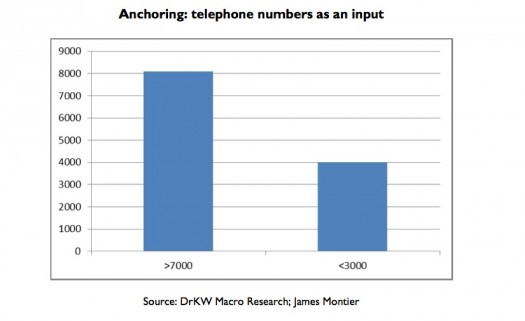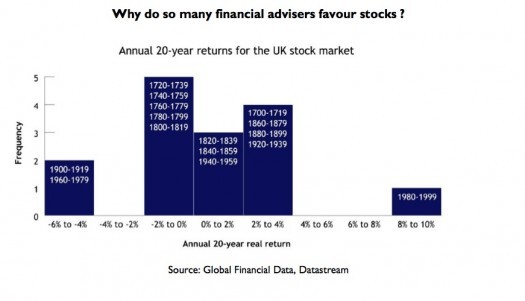An interesting study synopsis I read over at the Sovereign Man Blog.
May 22, 2013
London, England
James Montier’s bible on behavioural finance, ‘Behavioural investing’, points out two recent discoveries by neuroscientists that have relevance to all investors:
1) We are hard-wired to think short-term, not long-term
2) We also seem to be hard-wired to confirm to the herd mentality
A particularly intriguing experiment used by Montier to illustrate these points relates to our tendency towards ‘anchoring’.
In his words, anchoring is “our tendency to grab hold of irrelevant and often subliminal inputs in the face of uncertainty.”
Feel free to follow the experiment yourself:
1. Write down the last four digits of your telephone number.
2. Is the number of physicians in London higher or lower than this number?
3. What is your best guess as to the number of physicians in London?
The idea of this experiment is to see whether respondents are influenced by their phone number while estimating the number of doctors in London. The results of the experiment can be seen below:

As the chart indicates, respondents with last-four telephone digits above 7-0-0-0 suggested, on average, that there were just over 8,000 doctors in London. Those with telephone digits below 3-0-0-0 suggested 4,000 doctors. As Montier concludes, “This represents a very clear difference of opinion driven by the fact that investors are using their telephone numbers, albeit subconsciously, as inputs into their forecast.”
So our thesis goes as follows. In the absence of reliable knowledge about the future, investors have a tendency to anchor onto something – anything – to help them predict future market returns.
And what better anchor to use for future market returns than prior ones?
This is where the story gets more intriguing.
When looking at the UK stock market in discrete 20-year blocks, the period from 1980-1999 is the only one in the last 300-years in which inflation-adjusted returns averaged between 8% and 10% per year.

We think the story gets more intriguing still, because a good part of those returns was somewhat illusory in nature.
More specifically, given that they occurred during a once-in-a-century period of extraordinary credit creation, those market returns were in large part borrowed from the future. This is the same way that governments have been funded, and their colossal bond markets serviced– by essentially loading the ultimate cost and the final reckoning onto the next generation.
So it seems that investors are not anchoring their predictions of future market returns to the past, because, as the data shows, long-term real returns have been quite low.
Instead, investors are anchoring their predictions to the very recent past that they have direct experience with, i.e. the twenty-year period between 1980 and 1999, even though this period was an anomaly compared to the last 300-years.
If this thesis is even half correct, investors piling into stocks now on the premise of recapturing some of those 8% – 10% real annual returns, are being at least somewhat delusional. The credit bubble has burst. Messily. The stock market has not necessarily woken up to the fact. This does not detract from the sensible analysis of equity market opportunities.
But for any investment, its most important characteristic is its starting valuation. Buy attractive equities at sufficiently undemanding multiples and you should rightly expect to do well. Investors, however, seem to be anchoring their market predictions to recent returns of the past, therefore buying ‘the index’ expensively, inclusive of a grotesque bubble of credit. One can expect this to end in a train wreck.
London, England
James Montier’s bible on behavioural finance, ‘Behavioural investing’, points out two recent discoveries by neuroscientists that have relevance to all investors:
1) We are hard-wired to think short-term, not long-term
2) We also seem to be hard-wired to confirm to the herd mentality
A particularly intriguing experiment used by Montier to illustrate these points relates to our tendency towards ‘anchoring’.
In his words, anchoring is “our tendency to grab hold of irrelevant and often subliminal inputs in the face of uncertainty.”
Feel free to follow the experiment yourself:
1. Write down the last four digits of your telephone number.
2. Is the number of physicians in London higher or lower than this number?
3. What is your best guess as to the number of physicians in London?
The idea of this experiment is to see whether respondents are influenced by their phone number while estimating the number of doctors in London. The results of the experiment can be seen below:

As the chart indicates, respondents with last-four telephone digits above 7-0-0-0 suggested, on average, that there were just over 8,000 doctors in London. Those with telephone digits below 3-0-0-0 suggested 4,000 doctors. As Montier concludes, “This represents a very clear difference of opinion driven by the fact that investors are using their telephone numbers, albeit subconsciously, as inputs into their forecast.”
So our thesis goes as follows. In the absence of reliable knowledge about the future, investors have a tendency to anchor onto something – anything – to help them predict future market returns.
And what better anchor to use for future market returns than prior ones?
This is where the story gets more intriguing.
When looking at the UK stock market in discrete 20-year blocks, the period from 1980-1999 is the only one in the last 300-years in which inflation-adjusted returns averaged between 8% and 10% per year.

We think the story gets more intriguing still, because a good part of those returns was somewhat illusory in nature.
More specifically, given that they occurred during a once-in-a-century period of extraordinary credit creation, those market returns were in large part borrowed from the future. This is the same way that governments have been funded, and their colossal bond markets serviced– by essentially loading the ultimate cost and the final reckoning onto the next generation.
So it seems that investors are not anchoring their predictions of future market returns to the past, because, as the data shows, long-term real returns have been quite low.
Instead, investors are anchoring their predictions to the very recent past that they have direct experience with, i.e. the twenty-year period between 1980 and 1999, even though this period was an anomaly compared to the last 300-years.
If this thesis is even half correct, investors piling into stocks now on the premise of recapturing some of those 8% – 10% real annual returns, are being at least somewhat delusional. The credit bubble has burst. Messily. The stock market has not necessarily woken up to the fact. This does not detract from the sensible analysis of equity market opportunities.
But for any investment, its most important characteristic is its starting valuation. Buy attractive equities at sufficiently undemanding multiples and you should rightly expect to do well. Investors, however, seem to be anchoring their market predictions to recent returns of the past, therefore buying ‘the index’ expensively, inclusive of a grotesque bubble of credit. One can expect this to end in a train wreck.
No comments:
Post a Comment